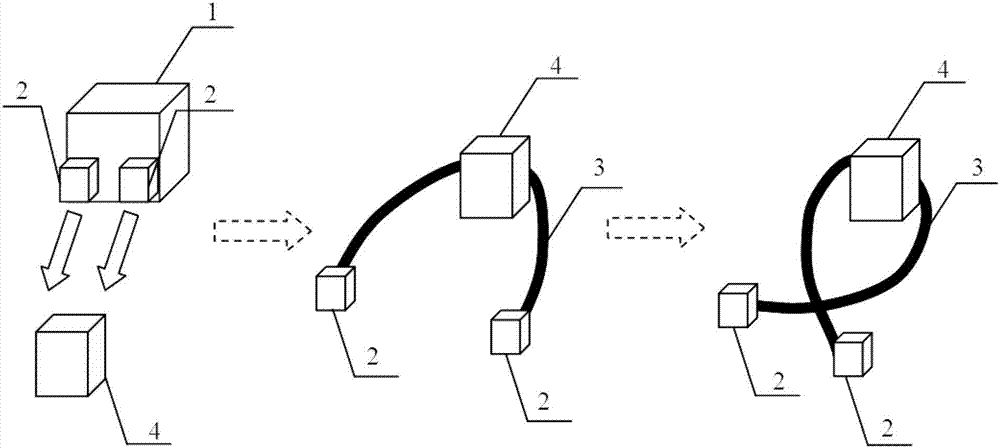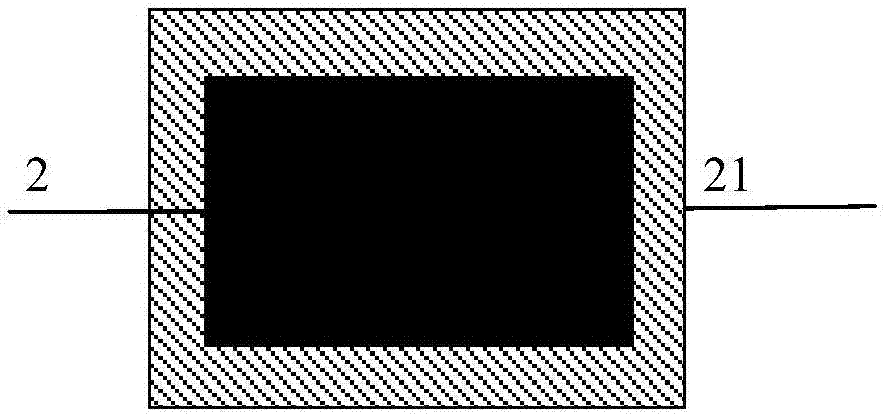Rope tied nano satellite system for space debris capturing
A space debris and tethering technology, which is applied in the directions of space navigation equipment, tools, transportation and packaging, can solve problems such as collision and energy exchange, failure of capture missions, and damage to the capture mechanism of spacecraft, and achieve economic benefits. High, the effect of preventing the target from escaping
- Summary
- Abstract
- Description
- Claims
- Application Information
AI Technical Summary
Problems solved by technology
Method used
Image
Examples
Embodiment 1
[0042] Such as image 3 As shown, it is a tether 3 with a hook and loop function, and the front and back double-sided tape-shaped hook and loop buttons are pasted on the front and back sides of the tether 3 respectively; bonding, such as Figure 4 As shown, after the tether 3 wraps around the space debris 4, the front hook and the back hook of the tether 3 contact and overlap each other. The bonding strength is related to the bonding material and buckle structure, the degree of compression during bonding, and the area of the bonding area.
Embodiment 2
[0044] Such as Figure 5As shown, it is a tether 3 with a magnetic attraction function. The tether 3 is a warp-knitted hollow-core tether. Beads 32 and NdFeB magnetic beads 32 have the same magnetic poles facing each other (black and white are two magnetic poles in the figure). Preferably, the middle section 33 of the rope is hollow so as to prevent the ferromagnetic core wire 31 from colliding with the high temperature resistant NdFeB magnets during storage. The beads 32 are entangled; when the tether 3 is in the storage state, the magnetic poles of the same name between the NdFeB magnetic beads 32 repel each other to avoid mutual attraction, such as Figure 6 As shown, when the tether 3 completes the winding of the space debris 4, the ferromagnetic core wire segment 31 and the NdFeB magnetic bead 32 segment of the tether 3 provide the attraction force between the ropes to attract and overlap each other.
Embodiment 3
[0046] Such as Figure 7 , 8 As shown, it is a tether 3 with a shape memory function. The tether 3 is made of a superelastic material, which can be beryllium bronze or carbon fiber, so that it forms a helical wrapping structure with a radius of curvature in a free state. ;Such as Figure 9 As shown, when the tether 3 completes wrapping around the space debris 4 , the space debris 4 will be wrapped up by virtue of the holding force of the helical wrapping structure of the radius of curvature of the tether 3 . The tether 3 is received at the end of the nanostar 2 before the launch of the nanostar 2 .
PUM
 Login to View More
Login to View More Abstract
Description
Claims
Application Information
 Login to View More
Login to View More - R&D
- Intellectual Property
- Life Sciences
- Materials
- Tech Scout
- Unparalleled Data Quality
- Higher Quality Content
- 60% Fewer Hallucinations
Browse by: Latest US Patents, China's latest patents, Technical Efficacy Thesaurus, Application Domain, Technology Topic, Popular Technical Reports.
© 2025 PatSnap. All rights reserved.Legal|Privacy policy|Modern Slavery Act Transparency Statement|Sitemap|About US| Contact US: help@patsnap.com



